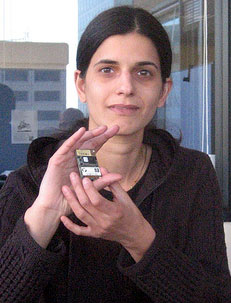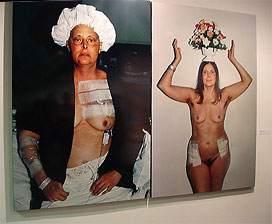Pigeons in Art: review of Beatriz da Costa’s recent work
1 Sep 2006
 Beatriz da Costa’s recent artwork for ZeroOne San Jose: Global Festival of Art on the Edge / ISEA2006[1] intersects with more than a few trends in new media art production worth mentioning. One, it is a data-gathering project. Two, it is fundamentally urban, since pigeons are an urban-located species. Three, it makes metaphorical relationships between, specifically, mobility and information. With the collection of pollution data as its main focus, it is also a work of public art dealing with environmental issues. The GPS monitoring and pollution detecting pigeons were released August 8th, an opening gesture for San Jose’s first big arts festival and each day thereafter, by the artist, for the rest of the festival’s week. Tiny nylon backpacks equipped with multiple useful devices, only costing in total a mere $250 per pigeon, (much cheaper than the Environmental Protection Agency’s data collecting stations which near $20,000 per) were mounted on each bird to relay data on carbon monoxide densities and other poisons to the web. On the website you are able to see flight paths for each bird above a city map and the data graphs. Da Costa spent many hours reducing the load each bird would bear by stripping the technology of any excess weight and researching more miniature tools.
Beatriz da Costa’s recent artwork for ZeroOne San Jose: Global Festival of Art on the Edge / ISEA2006[1] intersects with more than a few trends in new media art production worth mentioning. One, it is a data-gathering project. Two, it is fundamentally urban, since pigeons are an urban-located species. Three, it makes metaphorical relationships between, specifically, mobility and information. With the collection of pollution data as its main focus, it is also a work of public art dealing with environmental issues. The GPS monitoring and pollution detecting pigeons were released August 8th, an opening gesture for San Jose’s first big arts festival and each day thereafter, by the artist, for the rest of the festival’s week. Tiny nylon backpacks equipped with multiple useful devices, only costing in total a mere $250 per pigeon, (much cheaper than the Environmental Protection Agency’s data collecting stations which near $20,000 per) were mounted on each bird to relay data on carbon monoxide densities and other poisons to the web. On the website you are able to see flight paths for each bird above a city map and the data graphs. Da Costa spent many hours reducing the load each bird would bear by stripping the technology of any excess weight and researching more miniature tools.
Poetics of space
 The project humorously queries the idea of ubiquity, since pigeons are as ubiquitous as the cell phone and the large bird of the airplane is a prominent feature of San Jose. That miniaturization is a feature of the poetics of representation in art, from dolls mimicking humans to dollhouses, to toy trains and dioramas, as well as a feature of new technologies as they move towards tinier proportions, lends a certain poetry to these times and one which this project certainly has touched upon. In addition, artists have long been data gatherers. Joseph Cornell, another lover of birds, had drawers of found images and objects to use in his collages. Da Costa’s project touches on such metaphorical relationships, both for the city as it intersects with nature and for data gathering, which like bird flight, may be quite idiosyncratic as well as creatively transformed as “material” by new media. See the pigeonblog.
The project humorously queries the idea of ubiquity, since pigeons are as ubiquitous as the cell phone and the large bird of the airplane is a prominent feature of San Jose. That miniaturization is a feature of the poetics of representation in art, from dolls mimicking humans to dollhouses, to toy trains and dioramas, as well as a feature of new technologies as they move towards tinier proportions, lends a certain poetry to these times and one which this project certainly has touched upon. In addition, artists have long been data gatherers. Joseph Cornell, another lover of birds, had drawers of found images and objects to use in his collages. Da Costa’s project touches on such metaphorical relationships, both for the city as it intersects with nature and for data gathering, which like bird flight, may be quite idiosyncratic as well as creatively transformed as “material” by new media. See the pigeonblog.
The art seems to allude to an urban femininity in a variety of ways, even to privilege the polluted, “dirty bird” body as a cultural entity from which value is drawn.
This work is serious and subtle. It has a cute and comic aspect as well as the more serious critique of data collection conventions used by government agencies. Cultural reception of data and the production of data for a so-called “real” purpose, is often mired in conventions of “the real.” I think this is the strength of da Costa’s work. It frames data gathering as a convention tied to practices which help to dictate its reception. The birds with their backpacks are more scientifically useful than stationary technology:
The birds fly for about half an hour at between 300 and 500 feet. Their value to air quality researchers comes from their mobility, since they could potentially fill in pollution information between the stationary monitors researchers have to rely on, investigators said.[2]
 Lastly, it is hard to comment on this work without channeling the relationship between gender and birds and the fact that da Costa’s flock, have female names. The art seems to allude to an urban femininity in a variety of ways, even to privilege the polluted, “dirty bird” body as a cultural entity from which value is drawn. If such new electronic art is to deal with data and collecting practices (art collections? ) then we might ask: what are the politics around data findings, if there is one? How should that data become part of public ownership? I’m thinking of work that has been done in alternative art circles – projects such as the in LA in the 1970’s which mapped rape as a social phenomenon, or Hannah Wilke’s lymphoma photos, or Mierle Ukeles’ New York Sanitation Department projects, or the work of many others who have made efforts to bring “urban data” to the foreground of public consciousness, and to engage the public in new understandings of information. These histories of art – and there are so many – begin to erode traditional notions of information culture, the role of art and, even, science. How data is used and who sees and interprets it become central issues of the work. In da Costa’s case, she has managed also, to cross over into realms of poetic reflection on air itself, as well as flight, femininity, cultural absence and presence in the process of making.
Lastly, it is hard to comment on this work without channeling the relationship between gender and birds and the fact that da Costa’s flock, have female names. The art seems to allude to an urban femininity in a variety of ways, even to privilege the polluted, “dirty bird” body as a cultural entity from which value is drawn. If such new electronic art is to deal with data and collecting practices (art collections? ) then we might ask: what are the politics around data findings, if there is one? How should that data become part of public ownership? I’m thinking of work that has been done in alternative art circles – projects such as the in LA in the 1970’s which mapped rape as a social phenomenon, or Hannah Wilke’s lymphoma photos, or Mierle Ukeles’ New York Sanitation Department projects, or the work of many others who have made efforts to bring “urban data” to the foreground of public consciousness, and to engage the public in new understandings of information. These histories of art – and there are so many – begin to erode traditional notions of information culture, the role of art and, even, science. How data is used and who sees and interprets it become central issues of the work. In da Costa’s case, she has managed also, to cross over into realms of poetic reflection on air itself, as well as flight, femininity, cultural absence and presence in the process of making.
◊
1.
ZeroOne San Jose:
A Global Festival of Art on the Edge and the Thirteenth International Symposium of Electronic Art (ISEA2006) AUGUST 7-13, 2006
Images on www.flicker.com.
2. Barbassa, Juliana. ‘Pigeons with cell phones beam air quality info to blog’. sfgate.com. August 11, 2006.